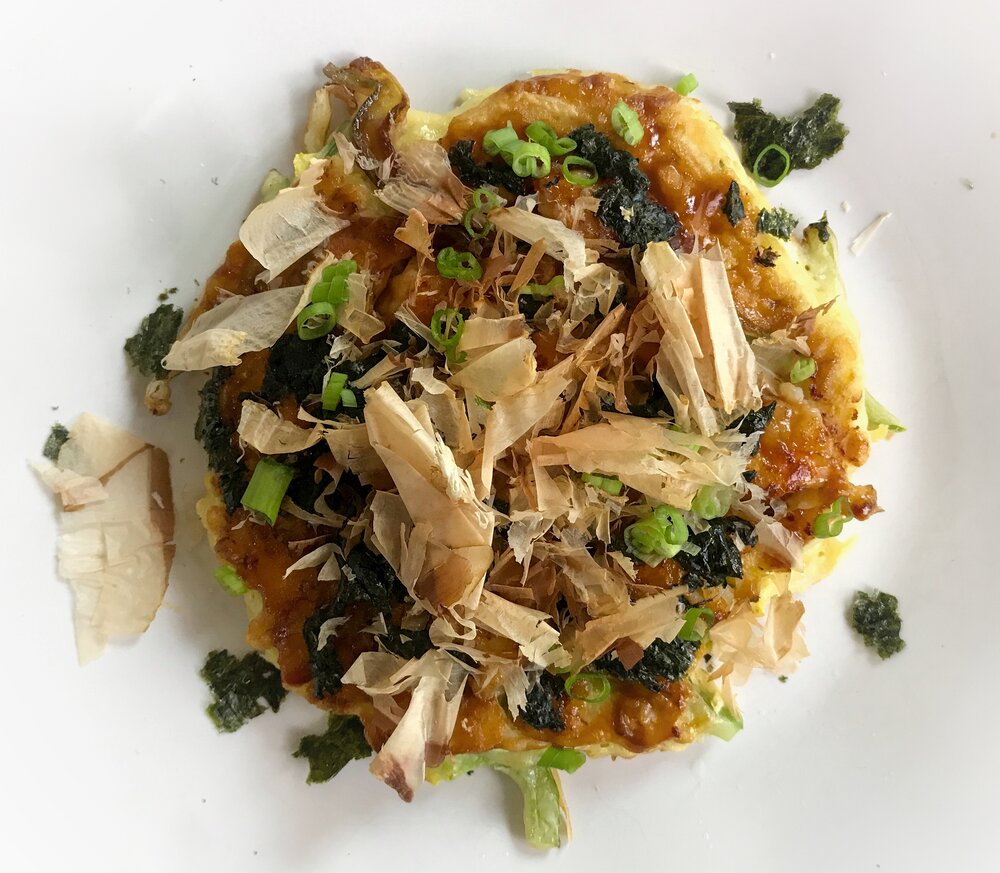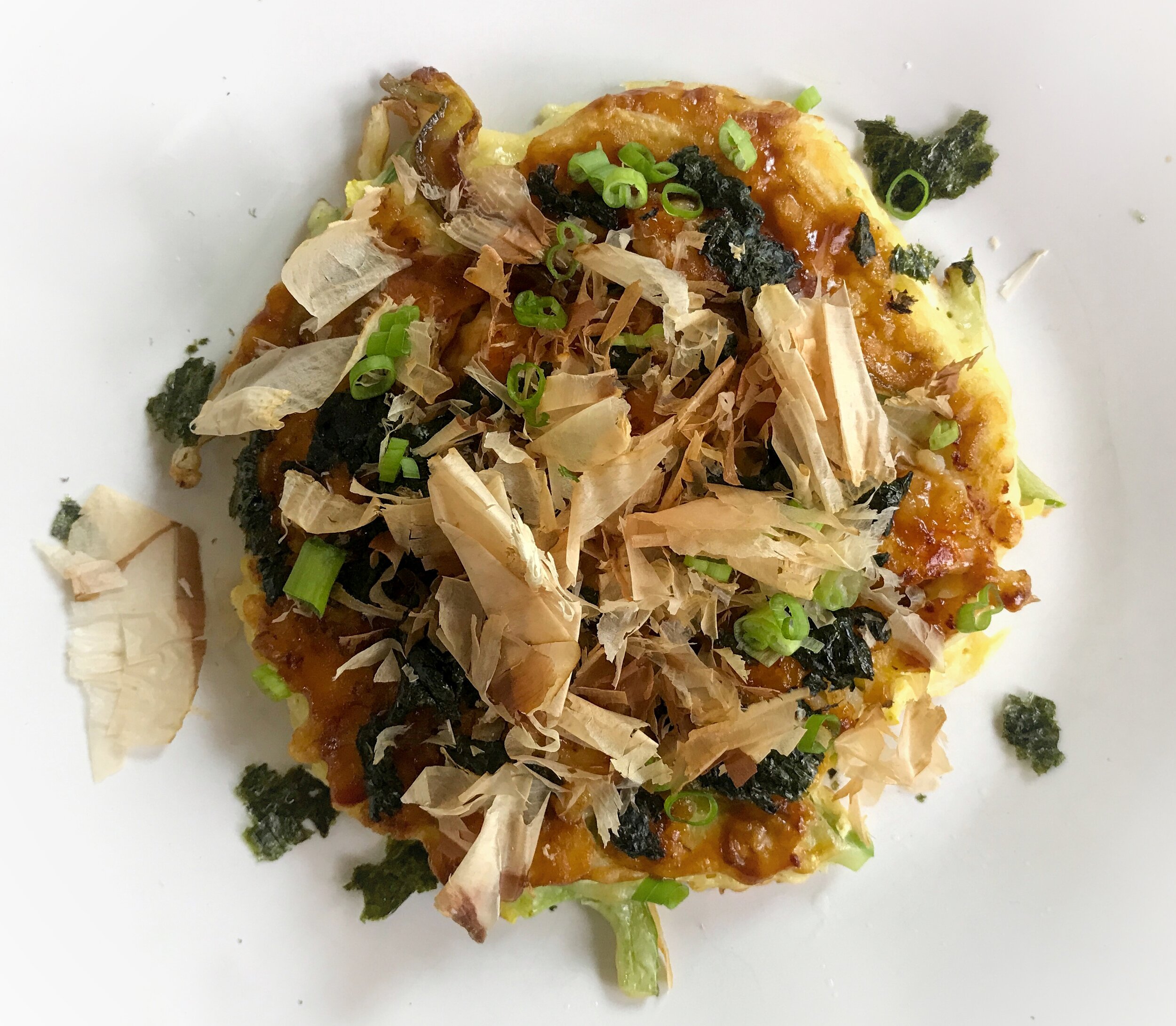Sonoko Sakai’s Okonomiyaki
This recipe is adapted from Japanese Home Cooking: Simple Meals, Authentic Flavors by Sonoko Sakai, which we reviewed in June 2020. The savory, bonito flaked-topped pancake called okonomiyaki dates back to Japan’s Edo period, when it was a snack for children. Back then, it was a flour-and-water pancake topped with miso and rolled up. Now it is made with a flour, water and egg batter with various vegetables (including cabbage and often bean sprouts) mixed in, and fillings such as shrimp, squid, octopus, thin-sliced pork belly or other meats, and cooked on an iron griddle.
Though it’s associated with the Kansai region and Hiroshima, you find okonomiyaki all over Japan, in slightly different styles. There are dedicated okonomiyaki restaurants throughout the country; in Tokyo there’s even an okonomiyaki district, a neighborhood called Tsukishima, near where Tsukiji fish market stood until 2018. The okonomiyaki places are often DIY spots, where the restaurant mixes up the batter according to the diner’s preference (okonomiyaki means “as you like it”) and the diner cooks it on the griddle. When it’s finished and flipped over, it’s cut into slices like a pizza and shared between friends.
In Osaka, people make okonomiyaki at home. And now that we know how to make it, thanks to Sakai’s book, we’ll be spinning on it endlessly.
When you make it for friends or family, make the pancakes one at a time, cut them up, share them — eating them while they’re hot (with beer!) before making the next one.
Makes 4 pancakes.
Ingredients
1 1/2 cups all-purpose flour
1 teaspoon baking powder
1/2 teaspoon salt
1 large egg, beaten
1 1/2 cups milk
8 ounces cabbage, thinly sliced
1/2 yellow, red or green bell pepper, thinly sliced
3 scallions, white and green parts, sliced
4 tablespoons vegetable or canola oil
8 ounces raw shrimp, cut into 1/2-inch pieces
2 tablespoons or more tonkatsu sauce (see recipe below)
2 tablespoons homemade Japanese mayonnaise or Kewpie mayonnaise (optional)
3/4 cup bonito flakes
1/2 cup crumbled nori or aonori flakes
Amazu shoga (pickled ginger) for serving
Instructions
1. Whisk together the flour, baking powder and salt in a small bowl.
2. In a medium bowl, whisk the egg and milk together. Add the flour mixture and mix until just blended. The batter should be quite thin. Add the cabbage, bell pepper and about 2/3 of the scallions to the batter and mix well.
3. Heat 1 tablespoon of the oil in a medium skillet over medium-high heat. Pour one-fourth of the batter to make a pancake. Cook until medium-brown on the bottom, about 1 minute. Place 1/4 of the shrimp on top of the pancake and then flip the shrimp side down. Turn the heat to low and cook until the bottom of the pancake is browned and the vegetables are tender, about 8 to 10 minutes.
4. Brush the pancake with tonkatsu sauce, sprinkle with 1/4 of the bonito flakes, 1/4 of the crumbled nori and 1/4 of the remaining scallions. Cut into four slices, and serve with the pickled ginger and eat it while it’s piping hot. Repeat until everything’s cooked.
Tonkatsu Sauce
Note: If you’re only going to use the Tonkatsu Sauce for one batch of Okonomiyaki, cut all the ingredients in half.
Makes about 2/3 cup.
Ingredients
1/2 cup Dashi (or 1/2 teaspoon HonDashi dissolved in 1/2 cup boiling water)
2 teaspoons dark brown sugar
1/4 cup ketchup
3 tablespoons soy sauce
3 tablespoons Worcestershire sauce
1/2 teaspoon freshly ground black pepper
1 teaspoon kudzu or potato starch, dissolved in 1 teaspoon water
Instructions
Bring the dashi to a boil in a small pot over medium-high heat. Add the remaining ingredients and cook until the liquid thickens and reduces by one-third, stirring frequently so it doesn’t burn, about 8 to 10 minutes. Keep in the fridge for up to 1 month.

Sonoko Sakai's Okonomiyaki
Ingredients
- 1 1/2 cups all-purpose flour
- 1 teaspoon baking powder
- 1/2 teaspoon salt
- 1 large egg, beaten
- 1 1/2 cups milk
- 8 ounces cabbage, thinly sliced
- 1/2 yellow, red or green bell pepper, thinly sliced
- 3 scallions, white and green parts, sliced
- 4 tablespoons vegetable or canola oil
- 8 ounces raw shrimp, cut into 1/2-inch pieces
- 2 tablespoons or more tonkatsu sauce (see recipe below)
- 2 tablespoons homemade Japanese mayonnaise or Kewpie mayonnaise (optional)
- 3/4 cup bonito flakes
- 1/2 cup crumbled nori or aonori flakes
- Amazu shoga (pickled ginger) for serving
- 1/2 cup Dashi (or 1/2 teaspoon HonDashi dissolved in 1/2 cup boiling water)
- 2 teaspoons dark brown sugar
- 1/4 cup ketchup
- 3 tablespoons soy sauce
- 3 tablespoons Worcestershire sauce
- 1/2 teaspoon freshly ground black pepper
- 1 teaspoon kudzu or potato starch, dissolved in 1 teaspoon water
Instructions
- Whisk together the flour, baking powder and salt in a small bowl.
- In a medium bowl, whisk the egg and milk together. Add the flour mixture and mix until just blended. The batter should be quite thin. Add the cabbage, bell pepper and about 2/3 of the scallions to the batter and mix well.
- Heat 1 tablespoon of the oil in a medium skillet over medium-high heat. Pour one-fourth of the batter to make a pancake. Cook until medium-brown on the bottom, about 1 minute. Place 1/4 of the shrimp on top of the pancake and then flip the shrimp side down. Turn the heat to low and cook until the bottom of the pancake is browned and the vegetables are tender, about 8 to 10 minutes.
- Brush the pancake with tonkatsu sauce, sprinkle with 1/4 of the bonito flakes, 1/4 of the crumbled nori and 1/4 of the remaining scallions. Cut into four slices, and serve with the pickled ginger and eat it while it’s piping hot. Repeat until everything’s cooked.
- Bring the dashi to a boil in a small pot over medium-high heat. Add the remaining ingredients and cook until the liquid thickens and reduces by one-third, stirring frequently so it doesn’t burn, about 8 to 10 minutes. Keep in the fridge for up to 1 month.
Recipe notes
• Sakai’s original recipe calls for any one of several types of protein — boneless chicken, shrimp, crab or sukiyaki-style beef or pork. We did not include those choices as we did not test any except shrimp.
• Her original batter recipe called for half as much salt, but we felt it needed more. We also added 1/4 extra milk because “the batter should be quite thin.” Ours was pretty thick, but the extra milk solved the problem.
• The original recipe called for two scallions in the batter, and none for garnish. We added one for garnish, partly because the photo in the book shows it that way and it looked so appealing.
• Sakai’s recipe does not mention Kewpie mayonnaise specifically; it just calls for Japanese mayonnaise and gives a page reference for her recipe.
• Sakai’s recipe for Tonkatsu sauce calls for either kukuto syrup, for which she provides a recipe, or dark brown sugar. We used dark brown sugar.




